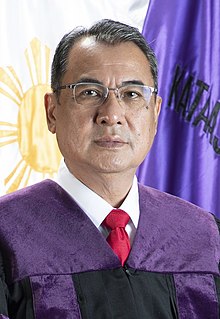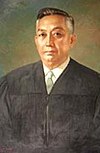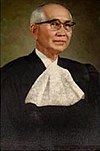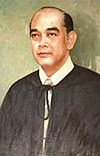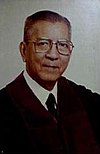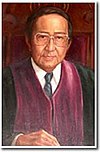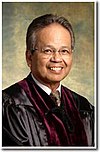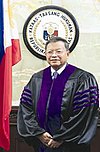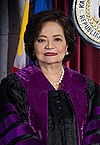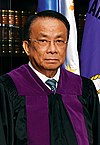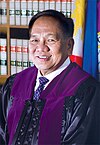In the English-American common law, quo warranto is a prerogative writ issued by a court which orders someone to show what authority they have for exercising some right, power, or franchise they claim to hold. The writ of quo warranto still exists in the United States, although it is uncommon, but it has been abolished in England and Wales. Quo warranto is also used, with slightly different effect, in the Philippines.

The Supreme Court (Filipino: Kataas-taasang Hukuman; colloquially referred to as the Korte Suprema, is the highest court in the Philippines. The Supreme Court was established by the Second Philippine Commission on June 11, 1901 through the enactment of its Act No. 136, an Act which abolished the Real Audiencia de Manila, the predecessor of the Supreme Court.
Impeachment in the Philippines is an expressed power of the Congress of the Philippines to formally charge a serving government official with an impeachable offense. After being impeached by the House of Representatives, the official is then tried in the Senate. If convicted, the official is either removed from office or censured.

Renato Tereso Antonio Coronado Corona was a Filipino judge who was the 23rd chief justice of the Philippines from 2010 to 2012. He served as an associate justice after being appointed by President Gloria Macapagal Arroyo on April 9, 2002, and later as Chief Justice on May 12, 2010, upon the retirement of Chief Justice Reynato Puno.

Conchita Carpio-Morales is a former Ombudsman of the Philippines serving from 2011 to 2018. Prior to her appointment as Ombudsman, she held the post of Associate Justice of the Supreme Court of the Philippines, served in the Lower Courts, as well as in the Department of Justice. She has secured appointments from five Philippine presidents: Ferdinand Marcos, Corazon Aquino, Fidel Ramos, Gloria Macapagal Arroyo, and Benigno Aquino III.

Presbitero Jose Velasco Jr. is the incumbent Governor of Marinduque and was a former Associate Justice of the Supreme Court of the Philippines. He was appointed to the Supreme Court by President Gloria Macapagal Arroyo on March 31, 2006.
An associate justice of the Supreme Court of the Philippines is one of fifteen members of the Supreme Court of the Philippines, the highest court in the Philippines. The chief justice presides over the high court, but carries only one of the 15 votes in the court. Traditionally, the chief justice is deemed primus inter pares among the justices.

Antonio Tirol Carpio is a former associate justice of the Supreme Court of the Philippines. He was sworn in as a member of the Supreme Court by President Gloria Macapagal Arroyo on October 26, 2001, and served until his retirement on October 26, 2019. He served as associate justice of the Supreme Court of the Philippines for a period of eighteen years. He also served as chief justice in an acting capacity several times during his tenure as Senior Associate Justice.

Teresita Leonardo de Castro is a Filipina who served as the 24th chief justice of the Supreme Court of the Philippines; she was appointed by President Rodrigo Duterte on August 28, 2018. She assumed the vacated position once her predecessor, Maria Lourdes Sereno, was removed via a quo warranto petition ; making De Castro the de jure 24th chief justice, and the first female chief justice of the Supreme Court.
Francisco Hernandez Villaruz Jr. is a Filipino justice. He was appointed on October 5, 2011, by President Benigno Aquino III as Presiding Justice of the Sandiganbayan replacing Justice Edilberto Sandoval who retired last June 20, 2011. Justice Villaruz has been an Associate Justice of the Sandiganbayan since 2001. He took his oath before Supreme Court Chief Justice Renato C. Corona last October 12, 2011.
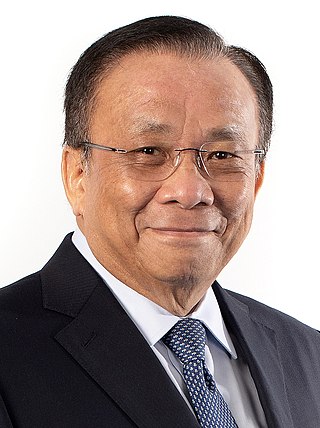
Lucas “Luke” Purugganan Bersamin is a Filipino lawyer and jurist who currently serves as the 40th Executive Secretary of the Philippines. Bersamin previously served in the Supreme Court of the Philippines for 10 years, first as an associate justice from 2009 to 2018 and then as the 25th Chief Justice of the Philippines from 2018 until his retirement in 2019. He was named by President Gloria Macapagal Arroyo to the high court as an associate justice on April 2, 2009. Prior to becoming an associate justice, he was a member of the Court of Appeals.

The presidency of Benigno Aquino III began on June 30, 2010, when he became the 15th president of the Philippines, succeeding Gloria Macapagal Arroyo. His term ended on June 30, 2016. Aquino, the third-youngest person elected president, is the only son of the 11th president, Corazon Aquino, and former senator Benigno Aquino Jr.

Maria Lourdes "Meilou" Aranal-Sereno is a Filipina lawyer and judge who served as de facto chief justice of the Supreme Court of the Philippines from 2012 until 2018.

Renato Corona, the 23rd chief justice of the Supreme Court of the Philippines, was impeached on December 12, 2011. Corona was the third official, after former President Joseph Estrada in 2000 and Ombudsman Merceditas Gutierrez in March 2011, to be impeached by the House of Representatives.
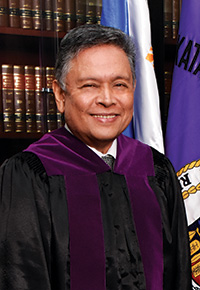
Noel Gimenez Tijam is a Filipino lawyer who served as an associate justice of the Supreme Court of the Philippines from March 8, 2017 to January 5, 2019. Prior to his appointment, he was a justice of Court of Appeals from 2003 to 2017.
The judiciary of the Philippines consists of the Supreme Court, which is established in the Constitution, and three levels of lower courts, which are established through law by the Congress of the Philippines. The Supreme Court has expansive powers, able to overrule political and administrative decisions, and with the ability to craft rules and law without precedent. It further determines the rules of procedure for lower courts, and its members sit on electoral tribunals.

The quo warranto petition against Maria Lourdes Sereno, filed before the Supreme Court of the Philippines, led to the landmark case Republic v. Sereno, which nullified Maria Lourdes Sereno's appointment as Chief Justice of the Supreme Court of the Philippines, finding that she never lawfully held the office due to a lack of integrity for failing to file certain required financial documents. As a result, she was ousted from the Supreme Court as Chief Justice. The Court handed down its ruling on May 11, 2018. The case began with a filing before the House of Representatives of an impeachment demand, the accusations in which Solicitor General Jose Calida used as the factual basis for his quo warranto petition.

Tranquil Gervacio S. Salvador III is a Filipino lawyer, educator, and civic leader. He has served as spokesperson and member of the defense panel for the impeachment of the then-Chief Justice Renato Corona and handled other notable cases of Filipino personalities and corporations.
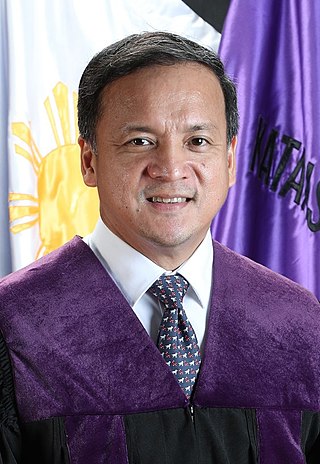
Jose Midas Pascual Marquez is an associate justice of the Supreme Court of the Philippines since 2021, and was previously the ex-member of the Office of the Court Administrator and the Supreme Court spokesperson of the Philippines. Marquez holds the record of being the longest-serving SC Court Administrator. Marquez was included in the final shortlist of official nominees as Associate Justice of the Supreme Court by Judicial and Bar Council, with the recommendation of Chief Justice Gesmundo, before being passed to the President for the appointment.
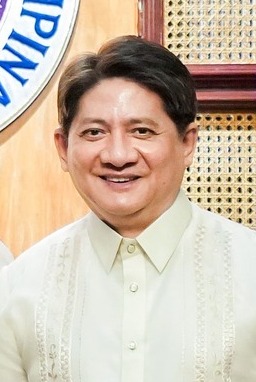
Lorenzo "Larry" Gacilo Gadon is a Filipino politician and disbarred lawyer who currently serves as the Presidential Adviser for Poverty Alleviation for President Bongbong Marcos since 2023. Gadon ran for a senatorial seat in 2016, 2019 and 2022 election, all of which were unsuccessful. Gadon has gained notoriety for his use of vulgar language and his hardline stance against perceived liberals and communists. Since 2019, he is one of the co-hosts of Karambola on DWIZ-AM.


